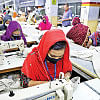Cotton farming not catching on for lack of govt support: experts

The expansion of cotton farming in Bangladesh has remained stagnant over the years due to a lack of sufficient farmland, manpower and government support, particularly in terms of innovation and investment.
As such, the country is still heavily reliant on imported cotton for its garment industry despite being the world's second-largest supplier of apparel items after China, according to various experts.
Cotton production in Bangladesh currently meets just 4 percent of the 85 lakh bales (each bale weighs about 218 kilogrammes) required by the country's 450 spinning mills annually.
Bangladesh imported cotton worth about $464.2 crore in fiscal 2021-22 while the country's garments exports fetched $4,260 crore that same year, as per official figures.
Officials of the Cotton Development Board (CDB) blame the absence of adequate research, manpower, land, and funds for the slow growth in domestic cotton production.
Cotton cultivation increased by an average of just 1 percent annually in the seven years to fiscal 2022-23, when total acreage stood at 45,000 hectares, according to the latest report by the CDB.
The CDB spent around Tk 160 crore to foster local cotton cultivation between fiscal years 2016-17 and 2022-23, but only managed to expand production by 3 to 4 percent.
In 2022, the CDB set a target to expand local cotton cultivation to 1 lakh hectares of land by 2030. But if things continue at the current pace, it will take the CDB another 170 years to reach this goal.
The CDB has developed only nine high-yielding varieties of cotton since its founding in 1972, resulting in a marginal rise in the country's cotton production.
The CDB spent Tk 30.58 crore on research in the four years between FY2019-20 and FY2022-23, but the outcome was a modest 9 percent rise in domestic cotton production.
This correspondent spoke with officials of three CDB research centres, all of whom said it is impossible to attain their target considering their funding and manpower limitations.
They also said that of the 880 approved posts in CBD research centres, 346 positions were vacant as of February this year.
The CDB research centres have only 8 or 9 officers in place against a sanctioned strength of 28, including the chief scientific officer, and senior and general scientific officers.
Mongsanue Marma, senior scientific officer of the Hill Cotton Research Centre in Bandarban, said the CDB lacks the level of expertise enjoyed by other agricultural research centres in the country.
"The cotton board cannot work properly with only 50 to 60 researchers. So, unless the government prioritises and invests in cotton research, we won't see good results," Marma added.
He also said domestic cotton production could increase by as much as 10 percent if they can attract qualified researchers to fill up vacant posts at the CDB research centres.
DMM Abed Ali, senior scientific officer of the CDB's Cotton Research, Training and Seed Multiplication Farm in Jashore, said 12 positions, including two scientific officer posts, remain vacant.
"If we can solve the manpower shortage, financial support will follow and thereby allow us to boost production," Ali said.
AH Md Kaikobad, a researcher at the CDB centre in Dinajpur, said apart from addressing the manpower crisis, policy support is needed to promote production.
"The government's main focus is on other cash crops. So, integrating cotton with cash crops could improve yields," he added.
Muhammad Ayub, former president of the Bangladesh Cotton Association, said bringing unused sugarcane and tobacco farmland under cotton cultivation could increase production by 10-12 percent.
Mohammad Ali Khokon, president of the Bangladesh Textile Mills Association, said cotton cultivation is being badly neglected in the country.
"The agriculture ministry is much more focused on cultivating food crops while cotton is not given enough attention," he added.
Khokon also said that if domestic cotton production could be boosted by 1 crore bales annually, it would create surplus income of up to $5 billion by decreasing the reliance on the comparatively expensive imported fibre.
The agriculture ministry recently announced that Tk 10 crore worth of incentives will be provided to increase cotton production for the first time in an effort to reduce import dependence.
"The government is providing around Tk 10 crore in incentives to cotton farmers. This shows that the agriculture ministry gives priority to cotton," said Fakhre Alam Ibne Tabib, executive director of the CDB.
He said Bangladesh has a very small amount of farmland in addition to a very large population.
"So, it is normal to focus more on food crops considering the limited amount of land. This is the main challenge for increasing cotton production," Tabib added.
He informed that they now plan to reduce tobacco farming to bring some of the land being used for that purpose under cotton cultivation instead.
Currently, cotton is cultivated in western Jhenaidah and Jashore and parts of the hilly districts of Bandarban and Rangamati.
Contacted, SM Mannan Kochi, president of the Bangladesh Garment Manufacturers and Exporters Association, said the quality of locally produced cotton is not as good as imported alternatives.
He also pointed to how it is challenging to increase cotton production in the face of land limitations.
"A solution may be found to this end if agricultural researchers work together," Kochi added.
Agriculture Minister Abdus Shahid declined to comment when asked about the reasons for low cotton production in the country.

 For all latest news, follow The Daily Star's Google News channel.
For all latest news, follow The Daily Star's Google News channel. 








Comments